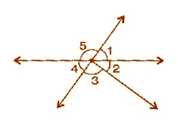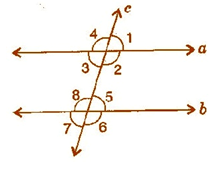Class 7 Maths
Lines and Angles

Ex. 5.1 Q.1
Find the complement of each of the following angles:
View Answer
Ex. 5.1 Q.2
Find the supplement of each of the following angles:
View Answer
Ex. 5.1 Q.3
Identify which of the following pairs of angles are complementary and which are supplementary:
(i) 650 ,1150 (ii) 630 ,270 (iii) 1120 ,680 (iv) 1300 ,500 (v) 450 ,450 (vi) 800 ,100
View Answer
Ex. 5.1 Q.4
Find the angle which is equal to its complement.
View Answer
Ex. 5.1 Q.5
Find the angle which is equal to its supplement.
View Answer
Ex. 5.1 Q.6
In the given figure, angle 1 and angle 2 are supplementary angles. If angle 1 is decreased, what changes should take place in angle 2 so that both the angles still remain supplementary?
View Answer
Ex. 5.1 Q.7
Can two angles be supplementary if both of them are:
(i) acute (ii) obtuse (iii) right?
View Answer
Ex. 5.1 Q.8
An angle is greater than 450. Is its complementary angle greater than 450 or equal to 450 or less than 450?
View Answer
Ex. 5.1 Q.9
In the adjoining figure:
(i) Is angle 1 adjacent to angle 2?
(ii) Is angle AOC adjacent to angle AOE?
(iii) Do angle COE and angle EOD form a linear pair?
(iv) Are angle BOD and angle DOA supplementary?
(v) Is angle 1 vertically opposite to angle 4?
(vi) What is the vertically opposite angle of angle 5?
View Answer
Ex. 5.1 Q.10
Indicate which pairs of angles are:
(i) Vertically opposite angles? (ii) Linear pairs?

View Answer
Ex. 5.1 Q.11
In the following figure, is angle 1 adjacent to angle 2? Give reasons.
View Answer
Ex. 5.1 Q.12
Find the values of the angles x, y and z in each of the following:
View Answer
Ex. 5.1 Q.13
Fill in the blanks:
(i) If two angles are complementary, then the sum of their measures is _______.
(ii) If two angles are supplementary, then the sum of their measures is _______.
(iii) Two angles forming a linear pair are _______________.
(iv) If two adjacent angles are supplementary, they form a _______________.
(v) If two lines intersect a point, then the vertically opposite angles are always ________.
(vi) If two lines intersect at a point and if one pair of vertically opposite angles are acute angles, then the other pair of vertically opposite angles are __________.
View Answer
Ex. 5.1 Q.14
In the adjoining figure, name the following pairs of angles:
(i) Obtuse vertically opposite angles.
(ii) Adjacent complementary angles.
(iii) Equal supplementary angles.
(iv) Unequal supplementary angles.
(v) Adjacent angles that do not form a linear pair
View Answer
Ex. 5.2 Q.1
State the property that is used in each of the following statements:
(i) If a||b, then Ð 1 = Ð 5.
(ii) If Ð 4 = Ð 6, then a||b.
(iii) If Ð 4 + Ð 5 + 1800, then a||b.
View Answer
Ex. 5.2 Q.2
In the adjoining figure, identify:
(i) the pairs of corresponding angles.
(ii) the pairs of alternate interior angles.
(iii) the pairs of interior angles on the same side of the transversal.
(iv) the vertically opposite angles.

View Answer
Ex. 5.2 Q.3
In the adjoining figure, p||q. Find the unknown angles.
View Answer
Ex. 5.2 Q.4
Find the values of x in each of the following figures if l||m
View Answer
Ex. 5.2 Q.5
In the given figure, the arms of two angles are parallel. If Ð ABC = 700, then find:
(i) Ð DGC (ii) Ð DEF
View Answer
Ex. 5.2 Q.6
In the given figures below, decide whether l is parallel to m.
View Answer